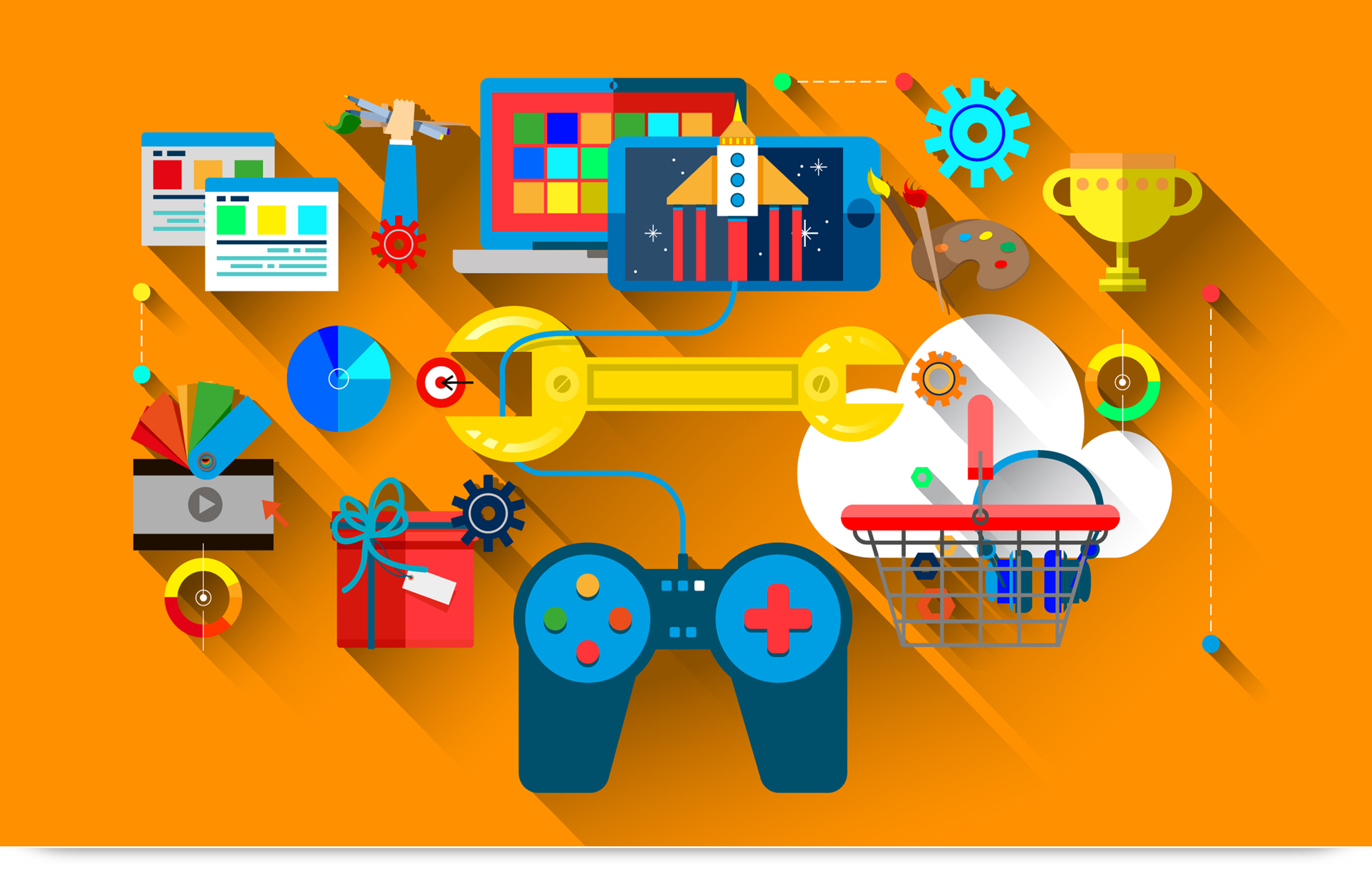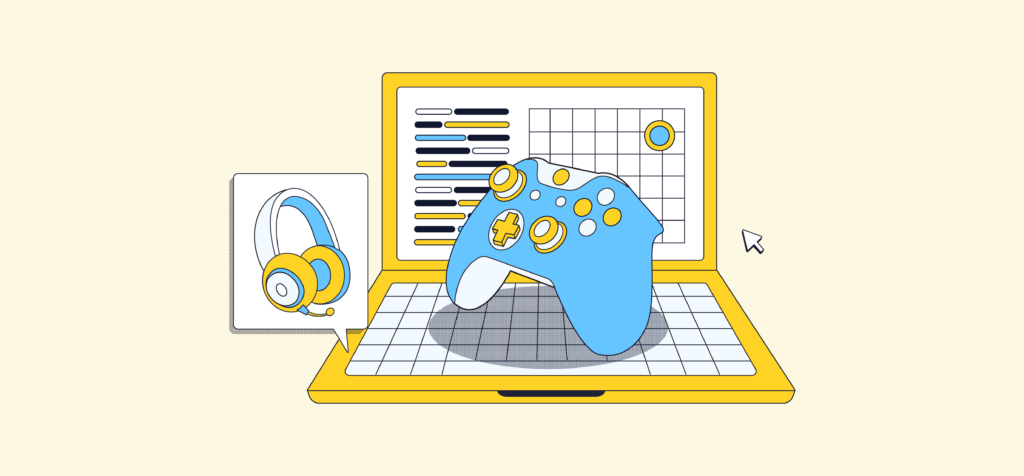Game development is the creative and technical process of creating video games. It encompasses design, coding, art, and sound production.
Delving into the world of game development reveals a multifaceted discipline where storytelling meets interactivity. Developers blend creative narratives with engaging gameplay mechanics to captivate players. Designing a game requires a clear vision and a deep understanding of the user experience to ensure the end product is both entertaining and functional.
Programmers, artists, game designers, and audio experts collaborate to bring virtual worlds to life. This teamwork is essential in a field that’s constantly evolving with technology, pushing the boundaries of what games can achieve. As an industry, it’s a dynamic space, offering endless possibilities for innovation and creativity, while also posing unique challenges such as platform compatibility, monetization strategies, and keeping up with consumer expectations.
Introduction To Game Development
Game development combines art, technology, and storytelling to create interactive experiences. It transforms creative ideas into games we love. From simple pixels to complex worlds, game development is a journey of innovation and passion.
Evolution Of Gaming
Gaming has come a long way from basic arcade games to immersive virtual realities. Each era brought new breakthroughs. Let’s look at gaming’s transformation over the years.
| Year | Milestone |
|---|---|
| 1970s | Arcade games like Pong debut |
| 1980s | Home consoles like NES launch |
| 1990s | 3D graphics in games emerge |
| 2000s | Online multiplayer games rise |
| 2010s | Virtual and augmented reality games appear |
Impact On Culture And Society
Games are more than just play. They shape our culture and touch lives. Let’s explore how.
- Community: Games connect people around the globe.
- Education: They teach problem-solving and strategy.
- Art: Games are a form of digital expression.
- Economy: The game industry creates jobs and revenue.
Core Skills For Aspiring Game Developers
Embarking on a journey into game development is thrilling and demanding. Success hinges on a diverse skill set that aspiring game developers must cultivate. This section delves into the core competencies necessary to thrive in the gaming industry.
Programming Languages To Master
Creating games requires proficiency in specific programming languages. These languages serve as the building blocks for game development.
- C++: Widely used for high-performance games.
- Java: Offers cross-platform capabilities, essential for mobile games.
- C#: The backbone of Unity, a popular game engine.
- Python: Known for simplicity, it’s great for beginners.
Understanding Game Mechanics And Dynamics
Game mechanics and dynamics are vital for engaging gameplay. These elements dictate how players interact with the game world.
| Game Mechanics | Game Dynamics |
|---|---|
| Rules | Player’s behavior |
| Objectives | Emotional responses |
| Rewards | Progression |
| Challenges | Storytelling |
Understanding these concepts leads to games that are fun and captivating.
Essential Tools And Technologies
Embarking on game development is an exciting journey. Key to this adventure are the essential tools and technologies. They turn ideas into stunning, playable realities. Understanding these tools is vital for success in the gaming industry. Let’s explore the most crucial ones.
Game Engines: A Comparative Analysis
Game engines are the backbone of game development. They provide a framework for game creation. Here are some top engines:
- Unity: Ideal for 2D and 3D games. It supports multiple platforms.
- Unreal Engine: Known for high-fidelity graphics. Great for AAA games.
- Godot: Open-source and customizable. It’s user-friendly for beginners.
| Engine | Pros | Cons |
|---|---|---|
| Unity | Flexible, multi-platform, large community | Can be resource-heavy |
| Unreal Engine | Advanced visuals, full source access | Steep learning curve |
| Godot | Free, lightweight, easy to learn | Limited resources compared to others |
Graphic Design Software For Game Artists
Game artists bring games to life with their designs. They need powerful software. Here are top choices:
- Adobe Photoshop: Top choice for 2D game art. It has many features.
- Blender: Free and open-source. It’s great for 3D modeling and animation.
- Substance Painter: For realistic textures and full material painting.
These tools help artists create amazing visuals. They shape the game’s look and feel.

Credit: www.chaostheorygames.com
Designing Compelling Game Worlds
Creating compelling game worlds is a core part of game development. This process involves more than just coding skills; it requires creativity, storytelling ability, and a deep understanding of what makes games fun. Let’s explore how developers craft these immersive environments.
Crafting Immersive Storylines
To capture players’ imaginations, developers create engaging storylines. These narratives drive the game forward and give context to the players’ actions. Key elements include:
- Strong character development: This helps players form emotional connections.
- Plot twists: Unexpected turns keep the gameplay exciting.
- Logical progression: Each event builds on the last, making the game coherent.
Using these elements, developers weave complex worlds that players are eager to explore.
Level Design: Balancing Challenge And Fun
Level design is crucial for game engagement. The goal is to balance difficulty and enjoyment. This ensures players are challenged but not frustrated. Key strategies include:
- Varying levels of difficulty: This keeps the game accessible for all players.
- Intuitive navigation: Players should find their way naturally.
- Rewarding exploration: Bonuses for exploration make it more enticing.
By carefully designing each level, developers create a smooth and rewarding gameplay experience.
Character Development And Animation
Game development brings stories to life. Character Development and Animation play vital roles. They transform code into beloved heroes and villains. Let’s dive into the art of crafting these digital beings.
Creating Memorable Characters
Great games need great characters. Creating memorable characters involves more than design. It’s about making a connection with the player.
- Personality: Characters need distinct traits.
- Backstory: A rich past makes characters relatable.
- Appearance: Unique styles set them apart.
- Progression: Growth hooks players throughout the game.
Designers use tools like sketches and storyboards. These help to shape the character’s journey.
The Role Of Motion Capture In Animation
Motion capture brings realism to character animation. Actors wear suits with sensors. This captures their movement.
| Benefits | Examples |
|---|---|
| Realistic Movements | Facial Expressions |
| Time Efficient | Full Body Actions |
| Cost Effective | Interactions |
Animations crafted from motion capture help players feel the game. They see characters move like real people.

Credit: www.gamedeveloper.com
Audio Design In Games
Audio design plays a crucial role in game development. It’s not just about the visuals; sound breathes life into the game world. Great audio design can make a good game feel fantastic. It shapes the atmosphere, sets the mood, and can even guide gameplay. Let’s dive into the world of game audio design.
Composing Original Scores For Games
Music sets the tone for a player’s experience. Composing an original score tailors the emotion and energy to the game’s storytelling. Imagine an epic boss battle or a serene exploration scene. The right music can make these moments unforgettable.
- Themes become iconic, think of classic games.
- Music adjusts with gameplay, creating dynamic experiences.
- Motifs represent characters or factions within the game.
Sound Effects: Enhancing Gameplay
Sound effects bring the game world to life. They inform players, often subconsciously. The crunch of gravel or the rustle of leaves can alert to danger or hidden treasures. Each sound effect is a piece of the puzzle that completes the gaming experience.
| Sound Type | Purpose | Impact on Player |
|---|---|---|
| Footsteps | Indicate movement | Alertness to surroundings |
| Weapon Clashes | Combat feedback | Excitement and tension |
| Ambient Noises | World-building | Immersion in the game’s environment |
Quality sound effects paired with intuitive audio cues enhance the gamer’s ability to make decisions and react to the game world. Realistic and well-timed sounds can significantly improve gameplay.
The Business Of Game Development
The world of game development is thrilling yet challenging. It blends creativity with strategic business practices. Understanding the business side is crucial for success, especially for independent developers.
Marketing Strategies For Indie Developers
Indie game developers often work with tight budgets. Effective marketing strategies are key to their success. Here are some cost-efficient methods:
- Social media campaigns: Use platforms like Twitter and Instagram to build a community around your game.
- Email marketing: Collect emails early on to keep potential players informed and engaged.
- Content marketing: Create engaging blogs and videos that tell stories about your game’s development.
Navigating The Publishing Landscape
Choosing the right publisher can make a big difference. Here are steps to guide you:
- Research publishers: Look for those with a track record in your game’s genre.
- Prepare your pitch: Your game’s concept, demo, and business plan must be clear and compelling.
- Negotiate terms: Focus on aspects like royalties, marketing support, and creative control.
Selecting a compatible publisher enhances your game’s chances of success.

Credit: www.udacity.com
Building A Portfolio And Breaking Into The Industry
Breaking into the game development industry can seem daunting. Yet, with the right portfolio, you stand out to potential employers. Your portfolio is your ticket to showcasing your skills. It’s time to build one that speaks volumes about your capabilities.
Showcasing Your Projects
A strong portfolio highlights your best work. Start by selecting diverse projects. Include game demos, code snippets, and art assets. Use clear, concise descriptions for each project.
Online platforms like GitHub or ArtStation let you share your work. Make sure your projects are accessible and easy to navigate. Consider adding a personal website to the mix for a professional touch.
- Quality over quantity: Choose your best work.
- Details matter: Explain your role and the tools used.
- Feedback is gold: Seek critiques and improve your work.
Networking And Continuing Education
Building connections is key in the gaming world. Attend game jams, conferences, and workshops. Engage with other developers online and offline.
Never stop learning. Online courses and tutorials help you stay current. They add new skills to your portfolio. This shows employers you’re serious about growth.
| Activity | Benefits |
|---|---|
| Game Jams | Practice skills, build prototypes |
| Conferences | Meet industry leaders, learn trends |
| Online Courses | Expand knowledge, learn new tools |
Remember, your portfolio and network reflect your passion. They open doors to exciting opportunities in game development.
Future Trends In Game Development
The realm of game development is rapidly evolving. Cutting-edge technologies are shaping how we interact with digital worlds. Let’s explore some exciting future trends that are set to revolutionize the gaming industry.
Virtual And Augmented Reality Games
Virtual Reality (VR) and Augmented Reality (AR) games are transforming gaming experiences. With VR headsets, players immerse in stunning 3D environments. AR games blend the digital and real worlds, creating interactive experiences.
- VR headsets become more affordable and powerful.
- AR applications grow beyond mobile, integrating with wearables and smart glasses.
- Games use spatial computing to make digital interactions feel more natural.
These advancements promise to make VR and AR games more mainstream. Players will enjoy more realistic and engaging gaming worlds.
The Rise Of Ai In Game Creation
Artificial Intelligence (AI) is revolutionizing game development. AI tools help create complex, lifelike characters and environments. They also streamline the game creation process.
- Procedural generation uses AI to create vast, unique game worlds.
- Machine learning helps design smarter game AI, making opponents more challenging.
- AI assists in automating tasks, such as testing and bug fixing.
AI is not just about smarter enemies. It’s about crafting richer, more dynamic game experiences. The future of game development is bright, with AI leading the charge.
Frequently Asked Questions
How Do I Become A Game Developer?
To become a game developer, start by learning programming languages like C++ or Java. Gain skills in game engines such as Unity or Unreal Engine. Build a portfolio with your own game projects and consider pursuing a degree in computer science or game design.
Network within the gaming industry.
Does Game Development Pay Well?
Game development can offer lucrative salaries, especially for experienced developers and those working at large studios or on successful projects.
Is Game Development Hard?
Game development can be challenging due to its complex blend of creative design, technical skills, and project management. It often requires a strong understanding of programming, art, sound design, and storytelling.
Is Game Developer A Good Career?
Game development is a promising career, offering creative fulfillment, diverse opportunities, and a growing industry with competitive salaries.
Conclusion
Embarking on a game development journey opens up a world of creativity and innovation. Whether you’re a beginner or an experienced developer, the field is ripe with opportunities for growth and exploration. Remember, the tools and techniques are at your fingertips; it’s your vision and persistence that will bring your game to life.
Dive in, keep learning, and enjoy creating something truly unique!

